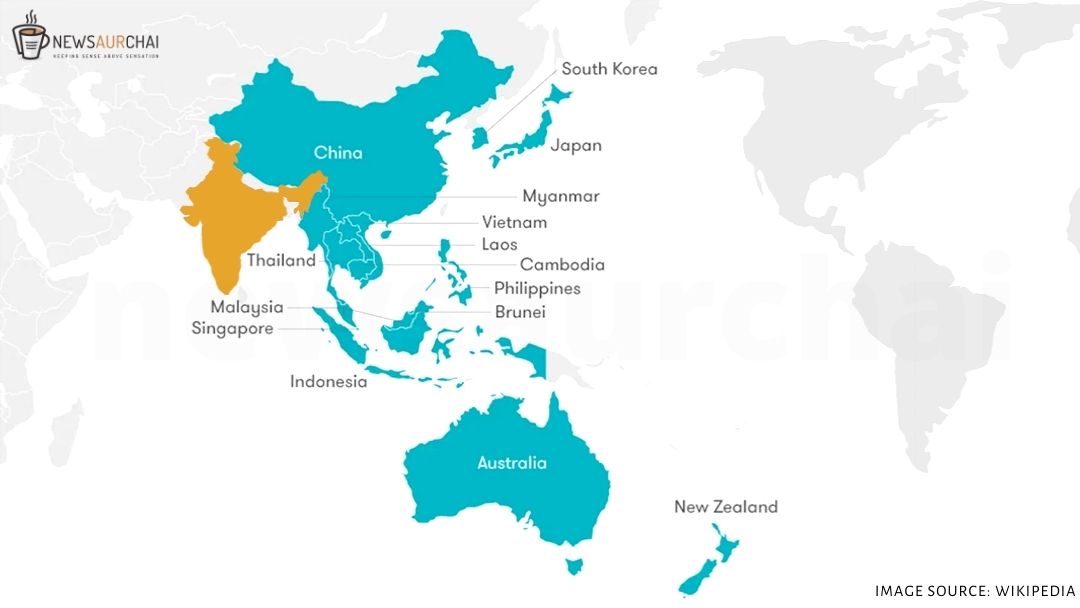
On November 15, Fifteen Asian Pacific countries with China’s backing have signed virtually the world’s biggest trade alliance, the Regional Comprehensive Economic Partnership (RCEP) which encompasses one-third of the global economy closely. The treaty is seen as China’s ambitious dominance in the South Asian market by fulfilling economic, geopolitical goals in the region.
TODAY: Leaders from 15 RCEP Participating Countries will witness the signing of the biggest Regional Trade Agreement, which is also an ASEAN-led mechanism. Learn more about #RCEP, its objectives, coverage areas and how RCEP contribute to regional economic integration:#ASEAN pic.twitter.com/gZrViNNvaW
— ASEAN (@ASEAN) November 15, 2020
Which all countries have signed?
The ten ASEAN (Association of Southeast Asian Nations) bloc countries include Brunei, Cambodia, Indonesia, Laos, Malaysia, Myanmar, the Philippines, Singapore, Thailand, Vietnam and with major Asian economic superpowers China, Japan, South Korea, Australia and New Zealand. India, one of the largest economies, stays out of the deal.
The RCEP free trade alliance is larger than the United States, Mexico, Canada Agreement and the European Union.
We signed the Regional Comprehensive Economic Partnership today. The RCEP shows Asian countries’ support for open & connected supply chains, freer trade & closer interdependence. – LHL https://t.co/Eu7swcj0a4 pic.twitter.com/SFvALeO05M
— leehsienloong (@leehsienloong) November 15, 2020
Aim behind RCEP:
The treaty aims at fulfilling member’s nations aspiration to strengthen the regional economic structure. In times like COVID-19, where globalisation is going backwards to extreme nationalism, the RCEP trade pact helps Asian Pacific nations to sustain their economy by entering into the largest agreement in terms of population, trade, market size and investment.
The RCEP trade pact was launched in 2011. After eight years of the talks, it was formally negotiated and accepted in 2020 by different high to low-income Asian countries amidst global pandemic.
Benefits:
RCEP set rules for trade that will facilitate investment and businesses within the region, a must for the Indo-Pacific’s post-COVID recovery. It is anticipated to eradicate a series of tariffs on imports imposed for 20 years. It also comprises specific rules on intellectual property, telecommunications, financial services, e-commerce and professional service.
There are already Free Trade Agreements (FTA) among member nations, but the limitation which RCEP tries to eliminate.
As per BBC, a good manufactured in Indonesia and contains Australian parts might face tariffs in the ASEAN free trade zone.
Under RCEP, parts from any member nation would be treated equally, which might give companies in RCEP countries an advantage to see within the trade region for suppliers. The deal is likely to benefit manufacturing nations of Japan, South Korea and China.
The pact is anticipated to take effect within the next two years when it is ratified by enough participating countries domestically.
China is leading and how:
With Europe dealing with terrorism and the second wave of COVID-19 and America’s ongoing elections and protests, China emerges as the dominant player in the Asian Market. Recently, it held 2nd virtual conference with major neighbours of India: Nepal, Bangladesh, Pakistan, Sri Lanka. This indicates China’s desire to rule and capture the Asian Market to become a major superpower in the world.
Absence of USA:
United States of America is missing from RCEP agreement after the USA pulled out itself from eleven nation Trans-Pacific Partnership (TPP) by the former President Donald Trump shortly after assuming administration. This leaves the world’s biggest economy, USA, out of two trade alliance that is regionally growing fast.
All eyes are on current President Joe Biden, and Vice-President Kamala Harris on their Trade strategy as Democrats believe in globalism to regain USA’s lost glory and control over South Asian Countries.
India stays out to protect itself:
New Delhi opted out from the world largest trade bloc last November citing “significant outstanding issues, which remain unresolved.” There is domestic opposition to safeguard the existing traditional primary Indian sector of handicraft, agriculture, small business.
Vocal for local – PM Modi’s new Mantra amidst Pandemic is to encourage the intra-regional trade in India and support Indian commodities to sustain ourself irrespective of external chaos.
Last year at Bangkok Summit PM Modi said “When I measure the RCEP agreement concerning the interests of all Indians, I do not get a positive answer. Therefore, neither the Talisman of Gandhiji nor my own conscience permits me to join RCEP.”
Some analysts believe India to be making a huge mistake for not sailing in the ship due to the present condition where it has to establish its export in the Asian Market. To quote former chief economic advisor of PM Modi government, Arvind Subramanian “foreign demand will always be bigger than domestic demand,” which means India needs to resist “the misleading allure of the domestic market.”
On the other hand, the outstanding issues of import tariffs play a considerable role with China benefiting maximum from the trade and India, which is already in the trade deficit in bilateral Chinese relation doesn’t see good opportunities in RCEP. This is a major concern for India, as its industry has voiced fears that cheaper products from China would flood the already flooded market.
Loose points of RCEP:
The RCEP agreement may not be enough to fit the unequal requirements of member countries as diverse as Vietnam, Malaysia, China, and Australia. Like the European Union, it fails to create unified norms on labour and the environment or commit countries to open services and other vulnerable areas of their economies. This may have a downfall, as when Greece or other European Nation fell, others came to help economically. The same does not apply to RCEP.
RCEP isn’t as comprehensive as TPP, which was Barak Obama’s brainchild to dominate Asia with 40 per cent of the world’s GDP being a part of it.
As far as India is concerned, being an original negotiating participant of RCEP still have the door open of joining the agreement without having to wait 18 months as decided for new members in the rules.





